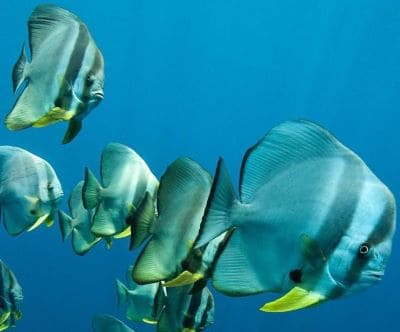Home › Sea Creatures › Marine › Vertebrates › Batfishes › Orbicular Batfish
Interesting Facts about Orbicular Batfish
[Phylum: Chordata] [Class: Actinopterygii (ray-finned)] [Order: Moroniformes] [Family: Ephippidae]
A deep, disc-shaped compressed body, and large symmetrical anal and dorsal fins are the standout characteristics of Ephippidae spadefishes.
This section contains fun facts and information about circular batfish (Platax orbicularis), including where they live, what they eat, and how they reproduce.
Platax Orbicularis Habitats and Distribution
The scientific name for the orbicular batfish is Platax orbicularis. But, it has several other common names, including:
- Circular batfish
- Cooper batfish
- Narrow-banded batfish
- Longfin batfish
- Orbiculate (orbic) batfish
- Round face batfish
You can find batfish living in most of the warm and temperate oceans around the world. There are more than sixty (60) species still in existence (extant) inhabiting the majority of saltwater and brackish environments, especially mangroves and lagoons.
The rounded batfish is a ray-finned fish that lives in superabundance in almost all Indo-Pacific regions, and even in parts of the western Atlantic Ocean (e.g. southern Florida).
Shallow, silt coral reef formations create natural habitats for batfishes, typically at depths above thirty metres (98 feet).
Batfish Characteristics and Behaviour
It is fair to characterise the adult deep sea batfishes by their broad (somewhat flattish) head with a slender body, but not rounded or triangular. The fan-shaped tail fin emphasises the fact that they are taller than their average length.
Some of these types of batfish also have rigid bumps on their skin. Many of the clade also have sharp spines, and others feature an elongated, upturned nose (snout).
Here's the thing:
Excluding circular batfishes, members of this genus are not good swimmers. In fact, you may see them using their adapted pectoral fins to walk along the bottom of the seabed when they hunt for prey.
Platax orbicularis grow to about forty (40) centimetres long. Even so, the biggest adult batfish can measure up to seventy (70) centimetres in length (28 inches). Thus, the disc-shaped Platax teira is a good example of the largest batfishes.
What Do Batfish Eat?
Being mostly a carnivorous ray-finned fish species, batfish tend to supplement their daily diet with a combination of:
 Crabs
Crabs- Dead jellyfish
- marine crustaceans (e.g. krill, mussels, scallops)
- Marine worms
- Sea snails
- Shrimp
- Small fishes
- Squids
However, most of the omnivorous batfish specimens feed on:
- Filamentous algae, turtle faeces, and seaweed
- Tiny aquatic invertebrates
How Do Batfishes Reproduce?
Even outside the mating season, adult orbicular batfish group together in small schools - and sometimes in large congregations. They prefer slightly murky or sandy protected structures, such as sunken shipwrecks. Nonetheless, the juveniles live more of a solitary lifestyle.
Female batfish reach sexual maturity after growing to about 32 centimetres long (13 inches). After laying pelagic eggs (meaning they spawn in open ocean), the baby batfish are vulnerable until they can feed on algae and small invertebrates.
Threats and Predators
Even though some batfish live in freshwater and are of some interest to the aquarium industry, most of the marine batfish live in deep water and have few natural predators. But, most of the shark phylum prey on the disc-shaped orbicular batfish.
Pro Tip: The IUCN Red List of Threatened Species assessed most global batfish species as being widespread and of "Least Concern" (LC).
Related Information and Help Guides
- Cardinal Fish Facts and Species Information
- Flashlight Fish Fun Facts and Information
- Goby Fish Facts and Interesting Information
- Marine Vertebrates with Examples and Pictures
- Wrasse Fish Species Interesting Information
Note: The short video clip [1:57 seconds] presented by "Amazing Planet!" contains footage of batfishes swimming in their natural habitat.